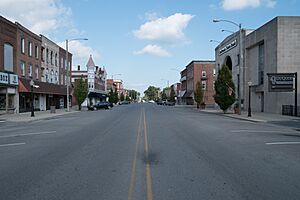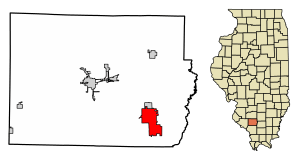Du Quoin, Illinois facts for kids
Quick facts for kids
Du Quoin
|
|
|---|---|

Du Quoin in September 2019
|
|
| Motto(s):
"In the heart of southern Illinois"
|
|

Location of Du Quoin in Perry County, Illinois.
|
|

Location of Illinois in the United States
|
|
| Country | United States |
| State | Illinois |
| County | Perry |
| Government | |
| • Type | Mayor-Council |
| • Body | City Commission |
| Area | |
| • Total | 7.06 sq mi (18.29 km2) |
| • Land | 6.98 sq mi (18.07 km2) |
| • Water | 0.08 sq mi (0.21 km2) |
| Elevation | 449 ft (137 m) |
| Population
(2020)
|
|
| • Total | 5,827 |
| • Density | 834.93/sq mi (322.38/km2) |
| Time zone | UTC−6 (CST) |
| • Summer (DST) | UTC−5 (CDT) |
| ZIP Code(s) |
62832
|
| Area code(s) | 618 |
| FIPS code | 17-21267 |
| GNIS ID | 2394564 |
| Public Transit | South Central Transit |
| Wikimedia Commons | Du Quoin, Illinois |
Du Quoin (pronounced doo KOYN) is a city located in Perry County, Illinois, in the United States. It's famous for two big events: the yearly DuQuoin State Fair and the Street Machine Nationals. In 2020, about 5,827 people lived here.
Contents
A Look Back in Time: Du Quoin's History
The area just east of Du Quoin is known as Old Du Quoin. In the early 1800s, Du Quoin was close to Lusk's Ferry Road. This was an important old road that connected Kaskaskia with Lusk's Ferry on the Ohio River.
Du Quoin began in its current spot in 1853. This was when the railroad tracks were built to reach this area. The city got its name from Chief Jean Baptiste Ducoigne. He was a leader of the Kaskaskia people, who were part of the Illiniwek group.
The very first mayor of Du Quoin was George Spencer Smith.
Where is Du Quoin?
The city of Du Quoin is found in the southeastern part of Perry County, Illinois.
According to the 2010 census, Du Quoin covers a total area of about 7.06 square miles (18.29 square kilometers). Most of this area, about 6.98 square miles (18.07 square kilometers), is land. A smaller part, about 0.08 square miles (0.21 square kilometers), is water.
What's the Weather Like?
| Climate data for Du Quoin, Illinois (1991–2020 normals, extremes 1895–present) | |||||||||||||
|---|---|---|---|---|---|---|---|---|---|---|---|---|---|
| Month | Jan | Feb | Mar | Apr | May | Jun | Jul | Aug | Sep | Oct | Nov | Dec | Year |
| Record high °F (°C) | 76 (24) |
79 (26) |
92 (33) |
92 (33) |
97 (36) |
106 (41) |
113 (45) |
113 (45) |
108 (42) |
96 (36) |
85 (29) |
76 (24) |
113 (45) |
| Mean daily maximum °F (°C) | 40.4 (4.7) |
45.7 (7.6) |
55.9 (13.3) |
67.5 (19.7) |
76.1 (24.5) |
84.4 (29.1) |
87.2 (30.7) |
86.4 (30.2) |
80.0 (26.7) |
69.0 (20.6) |
55.0 (12.8) |
44.4 (6.9) |
66.0 (18.9) |
| Daily mean °F (°C) | 32.1 (0.1) |
36.7 (2.6) |
46.0 (7.8) |
56.8 (13.8) |
66.1 (18.9) |
74.3 (23.5) |
77.4 (25.2) |
75.7 (24.3) |
68.3 (20.2) |
57.5 (14.2) |
45.2 (7.3) |
36.2 (2.3) |
56.0 (13.3) |
| Mean daily minimum °F (°C) | 23.9 (−4.5) |
27.7 (−2.4) |
36.1 (2.3) |
46.1 (7.8) |
56.1 (13.4) |
64.3 (17.9) |
67.6 (19.8) |
64.9 (18.3) |
56.6 (13.7) |
46.0 (7.8) |
35.5 (1.9) |
28.0 (−2.2) |
46.1 (7.8) |
| Record low °F (°C) | −22 (−30) |
−21 (−29) |
−10 (−23) |
20 (−7) |
29 (−2) |
39 (4) |
47 (8) |
43 (6) |
27 (−3) |
20 (−7) |
−4 (−20) |
−15 (−26) |
−22 (−30) |
| Average precipitation inches (mm) | 3.16 (80) |
2.90 (74) |
4.39 (112) |
5.35 (136) |
5.51 (140) |
4.79 (122) |
3.94 (100) |
3.30 (84) |
3.40 (86) |
3.66 (93) |
4.07 (103) |
3.24 (82) |
47.71 (1,212) |
| Average snowfall inches (cm) | 3.8 (9.7) |
3.2 (8.1) |
0.7 (1.8) |
0.1 (0.25) |
0.0 (0.0) |
0.0 (0.0) |
0.0 (0.0) |
0.0 (0.0) |
0.0 (0.0) |
0.2 (0.51) |
0.3 (0.76) |
3.6 (9.1) |
11.9 (30) |
| Average precipitation days (≥ 0.01 in) | 7.9 | 7.4 | 9.6 | 10.0 | 10.7 | 8.6 | 7.4 | 7.2 | 6.4 | 7.4 | 8.1 | 7.8 | 98.5 |
| Average snowy days (≥ 0.1 in) | 2.0 | 1.8 | 0.4 | 0.0 | 0.0 | 0.0 | 0.0 | 0.0 | 0.0 | 0.2 | 0.2 | 1.4 | 6.0 |
| Source: NOAA | |||||||||||||
Du Quoin experiences all four seasons. Summers can be hot, and winters can be cold with some snow. The city gets a good amount of rain throughout the year.
News and Radio in Du Quoin
Du Quoin has a local weekly newspaper called the Weekly-Press. You can also listen to local radio stations like WDQN AM 1580/FM 97.1 and WDQN-FM 95.9 FM. There used to be a daily newspaper, the Du Quoin Call, which was printed from 1895 until 2022.
Getting Around Du Quoin
Train Travel
Amtrak, which is the national passenger train system, offers service to Du Quoin.
- The southbound Saluki train leaves Du Quoin daily at 1:17 pm. It goes to Carbondale.
- The southbound Illini train leaves Du Quoin daily at 9:07 pm, also going to Carbondale.
- The northbound Saluki train leaves Du Quoin daily at 7:51 am. It travels to cities like Centralia, Effingham, Mattoon, Champaign-Urbana, and Chicago.
- The northbound Illini train leaves Du Quoin daily at 4:36 pm. It serves the same places as the northbound Saluki.
Bus Service
Public bus service in Du Quoin is provided by South Central Transit.
Education in Du Quoin
Du Quoin is part of the Community Unit School District (CUSD) #300. This district includes:
- Du Quoin Elementary School
- Du Quoin Middle School
- Du Quoin High School
The Elementary and Middle Schools are in buildings next to each other and share some common areas.
Fun Events in Du Quoin
The DuQuoin State Fair is a big event held every year in late August and early September. It has been happening since 1923. The DuQuoin State Fairgrounds Racetrack has hosted many types of racing over the years.
Today, the racetrack hosts a USAC Silver Crown Series race and an ARCA Menards Series race. From 1957 to 1980, Du Quoin was home to the Hambletonian Stakes. This is one of the most famous events in harness racing. It's also one of three races that make up the Triple Crown of Harness Racing for Trotters.
Du Quoin is also well-known for the Street Machines Nationals.
Nature and Parks
Du Quoin is a popular spot for Canada Geese. These geese migrate to the area for winter and then build their nests in the spring. It's common to see families of geese with 3 to 8 goslings (baby geese) in April and May.
Famous People from Du Quoin
Many interesting people have connections to Du Quoin:
- Terry Deering – An Illinois legislator, born in Du Quoin.
- Ralph A. Dunn – A businessman and Illinois state legislator.
- Edward Murray East – A plant geneticist, born in Du Quoin.
- Ruby Berkley Goodwin – A writer and actress, born in Du Quoin.
- Frank Hansford – A pitcher for the Brooklyn Bridegrooms baseball team, born in Du Quoin.
- Gerald Hawkins – An Illinois legislator, born in Du Quoin.
- Billie Hayes – An actress famous for playing Witchiepoo in H.R. Pufnstuf, born in Du Quoin.
- Nick Hill – A football quarterback and head coach at Southern Illinois, born in Du Quoin.
- Les Hite – A musician and bandleader, born in Du Quoin.
- John Iffert – A Roman Catholic Bishop.
- Bhavesh Patel – A theatre and television actor who lived in Du Quoin.
- Tyler Reddick – A NASCAR Cup Series race car driver who lived in Du Quoin.
- Charles Schlueter – A retired trumpet musician for the Boston Symphony Orchestra.
- Don Stanhouse – A pitcher for several baseball teams including the Texas Rangers and Baltimore Orioles, born in Du Quoin.
- Ken Swofford – An actor who appeared in Thelma & Louise and Ellery Queen, born in Du Quoin.
- Rudolf Wanderone – A famous billiards player known as "Minnesota Fats," who lived in Du Quoin.
Images for kids
See also
 In Spanish: Du Quoin para niños
In Spanish: Du Quoin para niños




